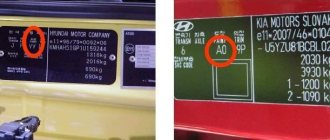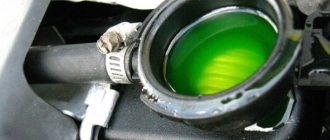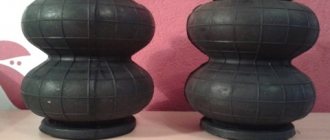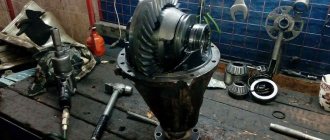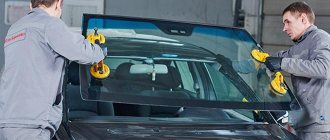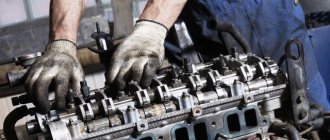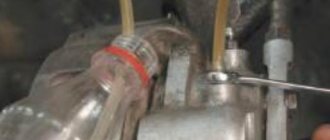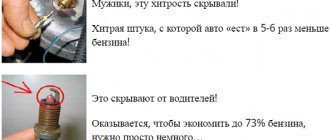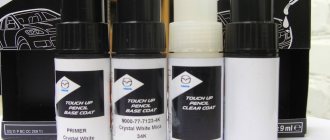DIY shock absorber repair
Almost every car enthusiast can repair shock absorber struts if he is not afraid of dirty work under the car.
At the same time, you will also be able to save a good amount of money. After all, as soon as dull knocks begin to appear in the car’s suspension when driving over holes and potholes, then it’s time to get serious about repairing the shock absorbers. Each automaker uses its own design developments to dampen vibrations when the vehicle is moving. But shock absorbers are present in almost all modern passenger cars.
The lifespan of a shock absorber is determined by the driving style of the car and the quality of the roads. For example, many 10-year-old cars from Europe with mileage of more than 200 thousand km come to us with “original” shock absorbers. And in our road conditions, a rare suspension part survives up to 100 thousand km.
At the end of this article you will find a visual video tutorial on how to repair the shock absorber strut of a VAZ 2110 car.
Below we will talk about what the main malfunctions of shock absorbers are, and how you can fix them yourself, if you have certain skills, tools and the desire to do this.
How to repair car shock absorbers
An article about how to repair car shock absorbers - types of breakdowns, methods for eliminating problems. At the end of the article there is a video about do-it-yourself shock absorber repair.
A car shock absorber is a device that absorbs vibrations or various shocks passing from the road surface to the body. Such vibrations of various systems are suppressed by pistons operating in viscous media. Thanks to such media, the amplitude of oscillations decreases.
Modern motorists are often faced with complete failure or breakdown of the suspension system, the main parts of which are shock absorbers. Therefore, urgent repairs are required, which will save the car owner from further complications. Such repairs should begin with detailed diagnostics.
Shock absorbers are available in rear and front. Repairing such critical parts requires detailed knowledge of the structure itself.
Main malfunctions of shock absorber struts
The main malfunctions of shock absorber struts are:
- Free movement of the rod in the cylinder,
- The presence of knocking noises when compressed or stretched,
- Oil leaks.
It is quite easy to detect all these problems without even removing the shock absorbers from the car.
To determine the performance of the shock absorbers, it is necessary to press firmly with your entire body weight several times on the fender or bumper of the car directly above each shock absorber in turn. If, after the car stops rocking, further vertical vibrations occur, then the shock absorber is faulty. Typically, a serviceable unit stops swinging immediately after the impact on it ceases.
Knocks in the shock absorber strut are detected in the same way. To do this, you should rest your palm on the top attachment point of the stand and swing it up and down with sharp rhythmic pressures. Impacts will be clearly felt upon contact.
To detect leaks in shock absorbers, just look between the wheel and the arch of the car. Turning the wheel to one side will help improve visibility. It is even more convenient for these purposes to use an inspection hole, overpass or lift.
Read more about methods for checking the serviceability of car shock absorbers in our article on how to check shock absorbers on a car.
What you need to know
Many motorists are engaged in repairing struts. Particular attention is paid to them in cases where the car shakes on the road, sways from side to side, and it objectively behaves unstable.
Before you disassemble a shock absorber that has leaked or failed, trying to revive it or simply change it, you need to make sure that it is faulty. We have already talked about how to check shock absorbers.
Here the main tools will be your ears and your eyes. If the suspension is working properly, which you are absolutely sure of, a knocking sound or traces of leaking oil may appear. This clearly indicates that the shock absorber requires attention. There is another checking option, but it is suitable for more experienced drivers who know the behavior of their car well. To do this, you need to go through the same turn several times at a certain speed. If the car starts to drift, the shock absorber is clearly not in order.
Although it is objectively correct and logical to contact a car service center, carry out diagnostics and get the most accurate diagnosis.
Removing shock absorbers
Repair of shock absorber struts begins with their dismantling. Removing shock absorbers usually does not cause problems. Unless the fasteners force the motorist to swear loudly and resort to drastic measures (“grinder” or gas “cutter”).
But most often it is enough to clean the nuts and bolts of sand and dirt, and then treat them with WD-40. After 20-30 minutes you can begin dismantling.
Here are a few points to consider when removing shock absorbers for subsequent repair or replacement:
- Often, the part of the car where the shock absorber is removed has to be lifted using a jack. Be sure to install stops under the threshold or bottom so that the car does not accidentally move during repairs.
- For better access to the lower fastening elements of the shock absorber, you need to remove the corresponding wheel.
- The upper mounting points for the struts in most cars are usually located under the hood and in the trunk.
In front-wheel drive vehicles, removing the strut will require more work. The complexity of the work depends on the type of shock absorber strut.
- Collapsible shock absorber designs are more difficult to dismantle the strut. To remove such a unit, you will have to unscrew the hub nut and remove the strut along with the hub.
- Non-separable shock absorbers have a simpler strut design. At the lowest point, the shock absorber is inserted into the cup, where it is secured with one or two bolts.
The upper mount for both types of struts is usually located under the hood (for front shock absorbers) and in the trunk (for rear shock absorbers). Here you only need to tighten two nuts.
Shock absorber struts on front-wheel drive vehicles are usually removed along with the springs.
Shock absorber malfunctions
Any car malfunction always manifests itself in the form of extraneous noise, unusual behavior of the vehicle or other signs. Problems with shock absorbers also have certain symptoms, and if they are detected, you should not delay replacing the dampers.
Oil leakage
The most common sign that a shock absorber has become unusable is a fluid leak. Leaks on the body indicate a loss of seal in the oil reservoir. As a result, not only leaks occur, but also air leaks. In this case, the damper rod has free movement, i.e. it moves without any effort, and the part loses its functionality. If signs of smudges have just appeared on the shock absorber, it will serve a little longer, but you should not leave it without attention and it is better to replace it in the near future.
Body rocking
Since springs and shock absorbers work together to dampen vibrations that occur when driving over bumps, contact with the road may be lost if the damper fails. In this case, shaking increases, the body sways, and the level of comfort decreases. The car becomes rolly, and when it hits obstacles it sways for some time. The easiest way to check the shock absorbers of your “seven” is to press the wing, try to rock the body, and then release it. If the car continues to swing on the springs for some time, then this is a clear sign of a faulty damper.
Body roll
One symptom that indicates problems with the suspension shock absorbers is body roll when cornering. This behavior of the car negatively affects safety, since the quality of braking, as well as vehicle control, suffers. If liquid has leaked from the damper, it will be quite difficult to keep the car turning, which is especially dangerous in winter. When the mileage of the products in question is more than 60 thousand km, which also depends on the quality of the parts themselves and the operating conditions of the vehicle, handling may noticeably deteriorate. But since the process does not occur at one moment, but gradually, the driver practically does not notice this and rolls can be perceived as a normal phenomenon.
Suspension noise
Extraneous sounds in the suspension, uncharacteristic of its operation, indicate the need to check and service this mechanism. When dampers and their bushings wear out, the ability to effectively support the weight of the machine is lost. In addition, so-called shock absorber breakdowns often occur.
Uneven or increased tire wear
If it has been noticed that the tire tread has uneven wear or wears off too quickly, then this is a clear sign of problems with the suspension. With faulty shock absorbers, the wheel moves vertically with a much greater amplitude, which leads to uneven tire wear. When driving, extraneous noise appears on such wheels.
Plunging when braking
Among car owners there is such a thing as “the car bites.” If the dampers fail, the front of the car will dive during braking, and the rear will sag when accelerating. This is explained by the fact that parts that have become unusable do not cope with their function, that is, they do not support the weight of the machine.
Broken fastening
One of the infrequent breakdowns of the front shock absorbers is the breakage of the lower eye. The reasons for this phenomenon may be different:
- installation of low-quality parts;
- making changes to the standard suspension design.
Sometimes it happens that the fastening of the rod along with the glass breaks off. This phenomenon is accompanied by a knocking sound while driving. It is quite easy to identify a breakdown by opening the hood and looking at the place where the upper part of the shock absorber is attached.
The problem is resolved by welding. Some Zhiguli owners reinforce this part of the body with additional metal elements.
DIY shock absorber repair
To determine the cause of a malfunction of the shock absorber strut on a front-wheel drive vehicle, most likely it will have to be completely disassembled. For more information on disassembling, reassembling and repairing the shock absorber, see the video tutorial at the end of this article.
An indispensable device for disassembling the shock absorber will be zip ties. This device for compressing springs is a powerful pin, on one end of which a left-hand thread is cut, and on the other, a right-hand thread. There is a hex key at the end of the stud. Clamps (with left and right threads, respectively) are screwed onto the ends of the stud, which will securely cling to the coils of the shock absorber spring when it is compressed.
- To compress the spring, two such tension devices are required. They are installed on opposite sides of the spring. Tightening is done by alternating rotation of the pins.
- When the spring is compressed enough that it can “move” freely in the strut, you can unscrew the top nut, remove the support bearing with the rubber bumper, and carefully remove the spring.
DIY shock absorber strut repair: what you need to know
Car shock absorbers are a part that experiences high loads during vehicle operation. Of course, when driving on bad roads, the service life of shock absorbers is greatly reduced.
At the same time, original struts for many models (especially for foreign cars of the middle and high class) are quite expensive spare parts. At the same time, cheaper analogues often do not differ in quality, and expensive non-original racks are often close in price to the original ones.
Naturally, the cost of such a service is often about 50% of the cost of a new shock absorber. For this reason, repairing the shock absorber struts yourself may seem like a more profitable solution. Let's figure out whether this is really so and whether it is worth repairing the car's shock absorbers at all.
Restoring struts: collapsible and non-dismountable shock absorber
A simple automobile shock absorber has the following design:
- lug body;
- rod with casing and mounting eye;
- piston, compression and return valves, rings;
- cylinder with valves;
- seals and fastening nuts.
First of all, the main problem of the shock absorber is leakage of oil or boost gas. As a result, the rack leaks, a knocking sound is heard during operation, and deformation of the rod is also possible. Violations of tightness and defects lead to changes in characteristics (partial or complete loss of performance). As a result, the car handles and brakes poorly, rolls, and does not hold the road, since the struts do not dampen the vibrations and sway of the body.
The main malfunctions include: free movement of the rod in the pipe, play during compression or rebound (workout in the rod or cylinder), damage to the shock absorber valves. It is also impossible to exclude external damage (case cracks, dents, etc.).
- To repair a gas and gas-oil collapsible shock absorber in a garage, you will need a compressor for supplying air (you can use a bicycle pump), a fitting for supplying compressed air, and a pressure gauge. Please note that you will have to work with high pressure; you should protect your eyes, hands, and face in advance.
Repair of a collapsible type rack begins with the rack being clamped vertically in a vice, washed of dirt, and the entry point of the rod is also blown with air. Next, disassembly of the shock absorber begins and the protective cap of the rod is removed. Then you need to fill the shock absorber under pressure; for this you need a pressure gauge.
The shock absorber can be filled with nitrogen, carbon dioxide and compressed air. In the garage, it is optimal to use compressed air for repairs. First, the rack is disassembled, cleaned, the O-rings are checked, and the condition of the inner wall of the pipe is assessed.
If the shock absorber has damage to the rod, seals or valves inside the strut, you can buy a repair kit for dismountable shock absorbers, remove “live” parts from another strut, etc. The main task is to install all functional parts to obtain complete tightness, while cleanliness is extremely important during assembly (debris and shavings will quickly damage the restored rack).
Bleeding the shock absorber is mandatory. Please note that shock absorber repairs must be done in pairs, just like replacements. In other words, repairing rear shock absorbers or repairing front struts involves manipulating both the right and left sides, that is, you need to restore both struts on the same axis.
- Now let's move on to how to disassemble a shock absorber and how to repair a non-dismountable shock absorber. Let us note once again that such parts are not officially repaired. However, repairs are possible, but they require skills and special equipment. In fact, usually non-separable shock absorbers are simply converted into collapsible struts.
Shock absorber diagnostics
Taking into account the main function of shock absorbers - reducing the rolling of the car on uneven road surfaces, the fault can be determined quite easily. The main sign of failure of this device is an increase in vibrations and the appearance of excess noise that was not felt before.
If the wheels of the car fall into a hole, you will be able to hear a piercing sound, which is also considered an additional sign of failure. This way you can find out if your shock absorbers need to be replaced or repaired quickly. However, a more detailed study of the problem will be required.
First, a visual inspection of the part and its careful study is necessary.
If an oil leak is detected, you should definitely carry out repairs and return the shock absorber to working condition. It is necessary to take into account that the process of diagnosing this device on a stand is a rather complicated task, so many people try to immediately purchase new shock absorbers or repair the struts using a repair kit on their own.
A shock absorber is considered to be a consumable item that must be replaced after a three-year period. The poor condition of Russian roads reduces this time significantly - the suspension fails much earlier than the time specified by the manufacturer. However, you should not despair in advance, nor should you throw away a broken part. If the shock absorber cannot be repaired, it can always be replaced.
Before choosing a method, you need to take into account several factors, including the cost of a new part - if it costs the car owner the same as the repair, you shouldn’t get your hands dirty. In addition, repairs require certain skills. Do not also forget that a reconditioned shock absorber will not last long.
Useful tips
As it may seem at first glance, you can restore the shock absorber with your own hands even in an ordinary garage. On the one hand, if the shock absorber is collapsible, this is so. However, the vast majority of modern cars use non-removable struts, that is, the manufacturer does not suggest the possibility of repairing them.
Of course, craftsmen restore such parts, but there are no guarantees for restored racks. We also note that the shock absorber on many cars is the basis, that is, a kind of supporting structure of the shock absorber strut as a whole. Of course, over time, the metal of its body accumulates “fatigue.”
Otherwise, like any other part, shock absorbers have a certain service life, after which they must be replaced. At the same time, attempts to restore shock absorbers that have exhausted their service life, although they allow you to save money, further driving on such struts poses a certain danger.
The correct approach is to timely check and replace the struts on the car, and not repair the shock absorber. Also, in order for the new racks to last longer, it is necessary to follow certain rules during the operation of the car:
- avoid making changes to the chassis design;
- carefully move over uneven surfaces;
- do not overload the car;
Also, oil and gas-oil shock absorbers require warming up in winter, when the first few kilometers need to be driven slowly and carefully, avoiding sudden acceleration and braking, driving over bumps at speeds above 30-40 km/h, etc.
When replacing struts, they must be bled. If the shock absorbers have just been installed, you need to do a wheel alignment. At the same time, it is necessary to check the entire suspension, do a full diagnosis of the chassis and eliminate existing faults (if detected).
Varieties
When you are confident that the shock absorber is to blame for all the troubles that happen to the car, you can begin repairs. Whether it consists of a complete replacement or simply restoration depends directly on what kind of shock absorbers you are dealing with.
- two-pipe oil;
- single-pipe gas;
- gas-oil;
- adjustable;
- collapsible;
- non-separable;
- with electronic adjustment;
- with magnetic adjustment;
- with hydraulic-mechanical adjustment;
- pneumatic, etc.
Each specific type of unit has its own recommendations and repair schemes.
First of all, I advise you to look at the instruction manual and understand exactly what components are installed on your car.
About 90% of modern cars are equipped with non-separable shock absorbers.
If in your case there is a set of gas, oil or gas-oil shock absorbers, and they are dismountable, there is a chance for restoration and restoration. For rear and front elements, the recommendations will be the same. Only dismantling is performed differently.
Restoration of gas devices
Since the price of new shock absorbers can sometimes be steep and unaffordable for some car owners, many try to solve the problem on their own.
Typically, gas shock absorbers are found on domestic cars, and these are mostly classics. But there are also exceptions.
In particular, gas shock absorbers can be found:
- at the Ural motorcycle;
- for Subaru Legacy;
- VAZ 2109;
- Mitsubishi Lancer 9;
- Renault Duster;
- UAZ 469;
- VAZ 2106;
- VAZ 2114;
- Moskvich, etc.
If you have determined that the car has gas elements, you can begin work on restoring them. Nobody gives a 100% guarantee, but there are chances, and they are quite large.
You need to start with dismantling. To do this you will need a pit or a lift. Next, the wheels are removed and the rack fasteners that the support holds are unscrewed. This is relevant for removing rear elements.
At the front, you usually need to completely remove the strut along with the brake disc. Nobody said it would be easy.
Now there are a few more important steps.
You need to do the following:
- remove the boot;
- unscrew the fastening nut;
- remove the shock absorber;
- replace the fluid;
- remove the gasket (seal) from the rod;
- remove the protective ring and oil seal;
- clamp the shock absorber in a vice;
- squeeze out the compression valve;
- remove the rod and piston;
- check all elements for defects.
If possible, problematic components are restored. But usually some of them need to be replaced. For such purposes, repair kits are provided in auto shops.
During dismantling, be sure to leave marks for the parts being removed so that you can later return them to their place in the correct sequence.
Put everything back in its place. The repair of the gas shock absorber can now be considered complete.
Working with oil shock absorbers
All primary stages are carried out in the same sequence as in the previous instructions. That is, you need to remove the elements, remove the excess, and carry out repairs.
Nobody disassembles oil shock absorbers into parts anymore. There is a special cartridge on sale. The old one needs to be removed and replaced with a new one. Then everything returns to its place. Afterwards, a wheel alignment must be carried out, and the shock absorbers are also pumped. You can try to do this yourself.
What's the result?
Taking into account the above information, it becomes clear that repairing car struts with your own hands is possible if necessary. In the case of collapsible shock absorbers, such repairs can be performed independently in a garage by studying the recommendations given in this article.
It is actually impossible to obtain any real guarantees for restored shock absorbers, and it is also difficult to determine how they will work (characteristics) and how long they will last (resource) after repair. As a result, the best solution would be to purchase new shock absorbers with a guarantee of quality and safety. The main thing is to buy original products, since there are a large number of low-quality fakes on the market, including shock absorbers of different brands and brands.
Restoring gas pressure in the rack
- The shock absorber is firmly fixed in a vice, the position is vertical. It is necessary to thoroughly clean the part and blow out the entry point of the rod with compressed air. It is disassembled - the protective cap of the rod is removed.
For convenience, work is carried out in a vice
Use a pressure gauge to control. The method is suitable for gas and gas-oil racks
The process can be seen in the video.
Video on how to pump gas in a gas-oil rack
There are different opinions on how to fill a car shock absorber. Nitrogen, carbon dioxide or just compressed air? In a garage setting, there are few options. Compressed air will not significantly degrade the performance, especially considering that this is a repair and not a factory-made rack.
Repair of shock absorber struts. Do-it-yourself instructions for an ordinary car
After the winter season, and after the spring too, when potholes appear on the roads (sometimes very deep), the car's shock absorber struts quickly become unusable. Most motorists simply throw them away when replacing them. TAKE YOUR TIME! It turns out that they can be effectively repaired, with your own hands and quite quickly. As usual today there will be a detailed text version + video...
Why repair shock absorber struts? YES it's simple. Imagine, you bought a MERCEDES S-CLASS, say, 10 - 12 years ago (well, “to show off”, “to show off”). And when the shock absorbers died, you were very surprised at the prices they were asking for (maybe 30, or even 40,000 rubles), because this is an S-CLASS, even if it’s used!
BUT there are companies that do repairs, and with a guarantee, they will restore the rack for you, say, for 3,000 - 5,000 rubles. The savings are obvious, some are 40,000, some are 3,000. But these are expensive cars, but what about, say, cheap cars, or at least our VAZs? KALINA, GRANT, PRIORA, etc. Is it possible to repair them and on a budget? It turns out yes, but in a different way.
In this material, I will tell you about two recovery methods: a complex one (the case with MERCEDES) and an easy and cheap case with a VAZ.
Complex shock absorber repair
Typically, the shock absorber strut repair process goes like this:
- The top metal part is cut off
- The oil seal is removed
- Drain the oil
- The insides are inspected, if they are in order (usually this is the case), they are left
- The stock is inspected. FOR corrosion, for runout. If necessary, it is straightened and sharpened on a machine.
- Next, a thread is cut on the body
- A large nut is turned out, which can be screwed onto a cut thread.
- The oil seal is replaced (for the rod, old or machined)
- The nut is screwed onto the thread from above and the gas pressure is pumped up.
Repair of the shock absorber strut ends here. The process is not easy, and it is advisable to trust it to professionals.
CONS: It is almost impossible to carry out such repairs yourself. Because you need special equipment (for example, a sharpening machine) to check for rod runout. We need new seals (it’s also unclear where to buy them), bypass valves, we need to somehow pump gas, etc. In general, if you have no experience or special equipment, then it’s even better not to meddle in this process. It still won't work.
The price of such repairs ranges from 3,000 to 5,000 rubles, possibly more for complex orders (for example, on heavy SUVs )
Easy rack repair
There is another type of repair. I conventionally called it “easy” - why? You just don’t need any skills or equipment, a standard hacksaw, a few drills and keys are enough.
YES, and it can be done by a person who has no experience at all in such repairs.
WHAT'S THE POINT? The stand is drilled, the oil is drained, the upper part is cut, and the insides are thrown out. The repair cartridge (aka shock absorber) is inserted into the old housing, secured, and EVERYTHING! Moreover, the price of such repairs is only 1400 - 1500 rubles.
Ask - “what kind of repair cartridge is this?” As I already wrote above, this is a ready-made shock absorber strut, just without fasteners, which goes inside the old body and is fixed there (it will be very detailed in the video below)
Currently, the Russian company RUSAM (an abbreviation for “Russian shock absorbers”) is developing such repair kits. It costs, as I wrote above, about 1,400 rubles, well, maybe a little more.
PROS: You don’t need almost any skills or equipment, “picking” or grinding through old internals, looking for bypass valve seals, etc. YES and the price is reasonable.
Thus, the front two shock absorbers (if they are restored) will cost only 2800 rubles (and if you buy new ones, in the store, the price tag is about 3000 - 3500 for one, that is, a pair is about 7000), I’m talking about our VAZs now.
MINUS: The company works only with our domestic cars, these are VAZ, GAZ, UAZ. No foreign cars yet! I would really like to. AND ALSO, the repair stand is slightly smaller in diameter, there are suggestions that it may boil during intense driving.
As you can see, repairing shock absorber struts is possible, which method is up to YOU to decide, of course. Some don’t bother at all and say “that it’s all bullshit”, of course there is some truth in their words, a solid, new part is of course better! However, it is only better when it is made with high quality.
Now let's watch a useful video.
This is where I end, I think my materials were useful to you. SINCERELY YOURS - AUTOBLOGGER
(
6 votes, average: 4.33 out of 5)
